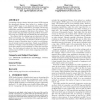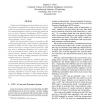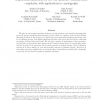15 search results - page 3 / 3 » Proofs of Storage from Homomorphic Identification Protocols |
CRYPTO
2005
Springer
13 years 10 months ago
2005
Springer
Forgery and counterfeiting are emerging as serious security risks in low-cost pervasive computing devices. These devices lack the computational, storage, power, and communication r...
MOBIHOC
2010
ACM
13 years 2 months ago
2010
ACM
Comparing with the classical barcode system, RFID extends the operational distance from inches to a number of feet (passive RFID tags) or even hundreds of feet (active RFID tags)....
PERCOM
2005
ACM
14 years 4 months ago
2005
ACM
Unique and challenging security problems arise due to the scarcity of computational, storage, and power resources in the low-cost pervasive computing environment. Particularly rel...
STOC
2007
ACM
14 years 5 months ago
2007
ACM
We give an exponential separation between one-way quantum and classical communication protocols for two partial Boolean functions, both of which are variants of the Boolean Hidden...
INFOCOM
2009
IEEE
13 years 11 months ago
2009
IEEE
—In order to protect privacy, Radio Frequency Identification (RFID) systems employ Privacy-Preserving Authentication (PPA) to allow valid readers to explicitly authenticate their...



